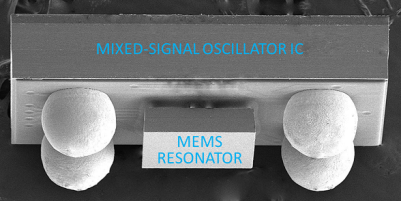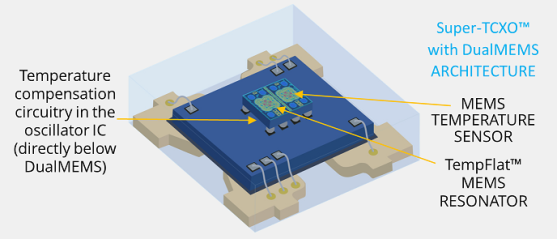5 hidden advantages of “micro” system timing
There are many benefits to using silicon MEMS timing – from low power and high performance, to reliability and resilience. And, of course, there’s the small size. This blog examines the advantages that come from the miniaturization of MEMS, their supporting circuits, and an all-silicon approach. We’ll cover package size, plus some of the less-obvious microsystem advantages that make a big impact.
Small Package
Starting with the obvious, as a micro-electro mechanical system, MEMS are inherently small. Silicon enables extreme scaling. Packaged parts, whether resonators alone or combined with their control electronics (e.g., oscillator IC), range from a few millimeters down to a fraction of a millimeter. MEMS oscillators typically consist of a silicon MEMS resonator stacked on a silicon mixed-signal IC. And because the main elements of a MEMS oscillator are silicon, advanced semiconductor packaging technology such as wafer-level chip-scale packaging (WL-CSP) can be applied, creating an oscillator that’s essentially the size of the silicon chips. This SEM image shows a CSP oscillator that requires no plastic, ceramic, or metal to house the chips.

1. More Robust
On to some facts you may not know… Silicon is 15 times stronger than titanium*. Add the fact that the moving mass of a MEMS resonator is up to 3,000 times smaller than a quartz resonator, and you get a highly robust device. This small mass reduces the force applied to a MEMS resonator from acceleration. (Remember Newton’s second law of motion?) Additionally, our resonators are designed with a stiff silicon center-anchored structure and controlled with advanced analog technology that makes them even more resistant to mechanical force. With less g force and our proprietary design, shock and vibration won’t disrupt performance. Jitter improves, frequency jumps disappear, and overall reliability greatly increases. Download our Shock and Vibration paper to learn more about the resiliency of MEMS timing.
2. Increased System Integration
Unlike quartz crystals, tiny MEMS resonators can be integrated into SoCs and multichip modules. Similar to how a MEMS is combined with an oscillator IC to make an oscillator, silicon MEMS resonators can be packaged with other silicon chips. For instance, MEMS can be embedded into modems in transceivers, or as real-time clocks within microcontrollers. These timing-integrated systems will appear to have no external timing references. A radio without an external frequency reference will look like a radio without a reference. The reference will still be there of course, only it will be integrated. Besides smaller size, the system is more reliable, robust, and lower power.
3. Less Phase Noise with Reduced Stray Capacitance
Noise can wreak havoc on a system. So how can size help? When resonators are small and are located near their sense amplifiers, the stray capacitance on the inputs of the amplifiers is reduced. Stray capacitance, as its name implies, is unwanted capacitance that directly and proportionally affects the input noise of the amplifiers. To understand this concept, consider the voltage noise on a high impendence amplifier, like a CMOS FET, being transduced into input current noise through the stray input capacitance, or the current noise of a low impedance amplifier being transduced into voltage noise through the stray input capacitance. Both are proportional to the capacitance. This input noise is then inversely proportional to the amplifier’s output phase noise. Low phase noise is important for virtually all applications.
4. Extended Circuit Functions
With integrated circuits nearby, it’s increasingly practical to include more functions within MEMS oscillators, giving them more flexibility and features. Today’s MEMS oscillators generally include fractional-N PLLs to translate the internal resonator frequencies to the desired output frequencies. These PLLs also compensate the resonator frequency over temperature and trim initial offsets. Further, the PLLs can modulate the output, for instance to reduce EMI with spread spectrum, or to adjust the frequency for tracking external signals. These circuits can be extended to provide multiple outputs of related frequencies or of controlled phases. One can think of these systems not so much as oscillators, but as frequency synthesizers.
5. Close Thermal Coupling
TCXOs (temperature-compensated oscillators) are a type of oscillator that provides precision frequency by measuring and compensating temperature. Traditional quartz TCXOs do this, but because of the distance between the crystal resonator and compensation measurement circuitry, there’s a lag in the feedback loop. This causes problems in modern electronic systems that have significant thermal gradients, which can be caused by a number of dynamic conditions. For example, power management systems cycle circuit block power. And cooling fans rapidly drop the ambient temperature. Not to mention all the external environmental stressors that you might find, for instance with outdoor equipment operating in a desert or in an automobile.

To overcome the effects of wide and rapid temperature swings, the temperature should be measured as close as possible to the resonator. Here’s where the small size and cohesive nature of all-silicon MEMS devices become especially beneficial. The close proximity of the MEMS resonator, MEMS sensor, and advanced compensation circuity in the latest generation of MEMS TCXOs (as shown in the diagram above), enable these devices to accurately measure and almost instantly respond to minute µKevin changes in temperature. These oscillators, which use a DualMEMS™ design (one for the resonator, another for the sensor) are designed to provide the most accurate temp compensation with particularly low noise. Download our DualMEMS paper or check out our Precision TCXOs to learn more.
Getting Moore with Less
The use of all-silicon elements have allowed MEMS timing to follow Moore’s law of packing more into less space with accelerated improvement over time. This scaling gives micromachined silicon resonators distinct advantages relative to other mechanical (non-silicon) resonators. In addition to miniaturization, MEMS have enabled significant improvement in robustness and unprecedented integration. Plus performance and feature benefits that stem from the compactness and cohesiveness of the system. As we progress in mechanical and integrated circuit design, and in fabrication capabilities, these advantages will escalate.
..............................................
* The ultimate strength (or tensile strength) of silicon is 5,000 to 9,000 MPa (megapascal, a measurement of pressure) compared to titanium at 246 to 620 MPa.
Thanks to Aaron Partridge, Founder and Chief Scientist at SiTime, for his contributions to this article.